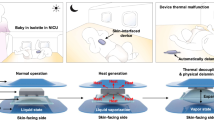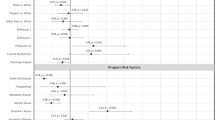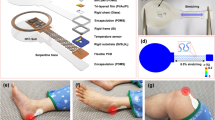Abstract
The role of a pressure clinic in reducing the incidence of pressure sores is described. Interface pressures are routinely measured to ensure that appropriate cushioning is provided. In patients most at risk, thermography is also valuable to ensure that the blood flow to the skin is not compromised. The implementation of such a clinic has proved successful and has resulted in a reduction of over 50% both in the incidence of sores and in the admission rate due to sores, when compared with studies from other spinal units.
Similar content being viewed by others

Log in or create a free account to read this content
Gain free access to this article, as well as selected content from this journal and more on nature.com
or
References
Egerton J, Grundy D, Russell J (1986) ABC of spinal cord injury. Nursing. Br Med J 292: 325–329.
Donovan W H, Carter R E, Bedbrook G M, Young J S, Griffiths E R (1984) Incidence of medical complications in spinal cord injury: patients in specialised, compared with non-specialised centres. Paraplegia 22: 282–290.
Carvell J, Grundy D (1989) Patients with spinal injuries. Early transfer to a specialist centre is vital. Br Med J 299: 1353–1354.
Archibald R (1982) A co-ordinated programme of follow-up care. Reported, but unpublished study, Edenhall Spinal Injuries Unit, Edinburgh.
Lawes C J (1984) Pressure sore readmission for spinal injured people. Care, Science and Practice 4(2): 4–8.
Rogers, J E (1973) Tissue trauma group. In: Annual Report of Progress, Rehabilitation Center at Rancho Los Amigos Hospital.
Key, A G, Manley M T, Wakefield E (1978) Pressure redistribution in wheelchair cushion for paraplegics: its application and evaluation. Paraplegia 16: 403–412.
Ferguson-Pell M W, Wilkie I C, Reswick J B, Barbenel J C (1980) Pressure sore prevention for the wheelchair-bound spinal injury patient. Paraplegia 18: 42–51.
Noble P C (1981) The prevention of pressure sores in persons with spinal cord injuries. Monograph 11. International Exchange of Information in Rehabilitation, New York.
Ferguson-Pell M W (1983) Seating for patients vulnerable to pressure sores In: Barbenel JC, Forbes CD, Lowe GDO editor. Pressure Sores, Macmillan London: 15–25.
Rothery F A (1989) Preliminary evaluation of a pressure clinic in a new spinal injuries unit. Paraplegia 27: 36–40.
Robertson J C, Shah J, Amos H, Druett J E, Gisby J (1981) An interface pressure sensor for routine clinical use. Eng Med 9: 151–156.
Bader D L, Gant C A (1988) Changes in transcutaneous oxygen tension as a result of prolonged pressures at the sacrum. Clin Phys Physiol Measure 9: 33–40.
Shakespeare P G, Swain I D (1985) Skin blood flow and TcP02 measurement. Biological Engineering Society Conference Proceedings, Dundee: 78–87.
Black R, Filippone A F (1980) Thermography in a seating program. Digest of the 8th Canadian Medical and Biological Engineering Conference: 167–168.
Bar C A (1989) The response of tissue to applied pressure. PhD Thesis, University of Wales, Cardiff.
Author information
Authors and Affiliations
Rights and permissions
About this article
Cite this article
Dover, H., Pickard, W., Swain, I. et al. The effectiveness of a pressure clinic in preventing pressure sores. Spinal Cord 30, 267–272 (1992). https://doi.org/10.1038/sc.1992.67
Issue date:
DOI: https://doi.org/10.1038/sc.1992.67


